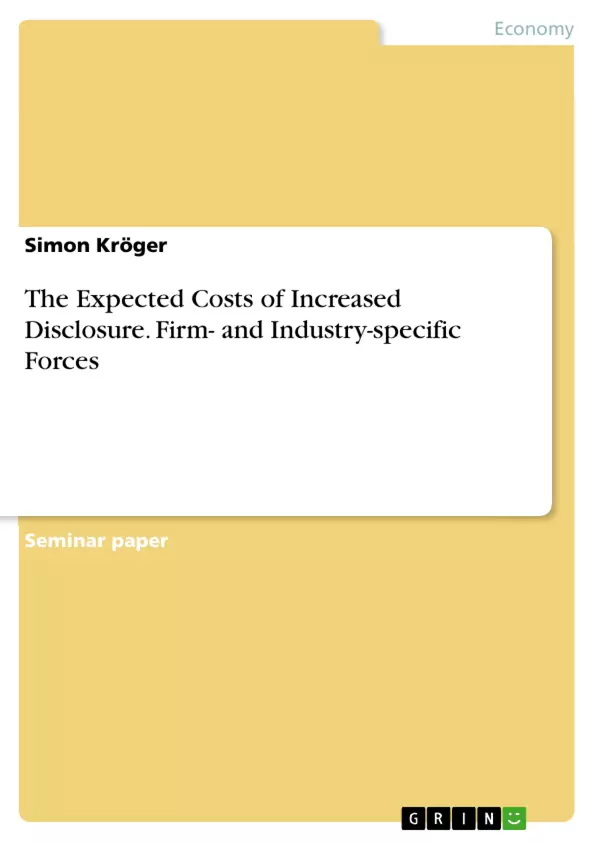A series of financial crises and corporate scandals gave rise to increasing concerns about prevailing models of corporate governance and disclosure and stimulated financial disclosure and reporting regulation. As a result, there has been considerably more interest in documenting the benefits of increased disclosure than its costs. Accordingly, numerous papers purport to provide evidence of capital market benefits through incremental disclosure.
At the same time, firms refrain from voluntarily committing to increased disclosure, implying that there must be a trade-off between associated benefits and costs. Consequently, critics contend that the capital market benefits are inconclusive. Instead, increased disclosure may result in adverse capital market effects through increasing information asymmetry. Moreover, critics predict that increased disclosure imposes further costs on the firm.
The purpose of this seminar thesis is to review existing literature on these expected costs of increased disclosure. Thereby, I focus on controversies regarding the heavily debated capital market effects as well as on specific forces that determine proprietary and litigation costs associated with increased disclosure. While a firm’s disclosure choices likely are a joint outcome of market forces and incentives provided by regulation, the seminar thesis is limited to voluntary disclosure choices as a starting point for possible disclosure regulation.
The remainder of the seminar thesis is structured as follows. Section 2 reviews the literature on the capital market effects of voluntary disclosure through its impact on information asymmetry. Section 3 discusses the ambiguous impact of voluntary disclosure on litigation and proprietary costs. Section 4 concludes the seminar thesis.
Inhaltsverzeichnis (Table of Contents)
- Introduction
- The Capital Market Effects of Increased Disclosure
- Ambiguous Predictions about the Capital Market Effects: Information Asymmetry as Link between Public Disclosure and Capital Market Outcomes
- The Effect of Increased Disclosure on Information Asymmetry: A Complementary versus Substitutive Relationship between Private and Public Information
- The Effect of Information Asymmetry on Capital Market Outcomes
- Empirical Evidence on the Capital Market Effects
- Reduction of Information Asymmetry through Increased Disclosure
- Capital Market Benefits through Voluntary Disclosure
- Conflicting Evidence and Reservations about Empirical Studies Implying Capital Market Benefits
- The Ambiguity of Expected Cost of Disclosure
- Litigation Costs: Dependence on Disclosure Horizon and Tone
- Theoretical Predictions: Preemption Effect versus Chilling Effect
- Preemption Effect: Reduction of Litigation Costs through Increased Disclosure
- Chilling Effect: Rise of Litigation Costs through Increased Disclosure
- Proprietary Costs: Dependence on the Nature of Competition
- Limitations of Studies Utilizing Industry Concentration-based Measures
- Linking the Nature of Competition to Proprietary Costs
- Competition from Market Incumbents versus Competition from New Entrants
- Difficulties Identifying the Nature of Competition
- Establishing a Link between the Nature of Competition and Proprietary Costs
- Additional Forces Impeding a Distinct Link between Disclosure and Proprietary Costs
- Litigation Costs: Dependence on Disclosure Horizon and Tone
- Conclusion
Zielsetzung und Themenschwerpunkte (Objectives and Key Themes)
This seminar thesis aims to provide a comprehensive review of existing literature regarding the expected costs of increased disclosure. It delves into the controversial capital market effects of disclosure, exploring the impact on information asymmetry and the specific factors influencing proprietary and litigation costs. While acknowledging the complex interplay between market forces and regulatory incentives, the thesis focuses on voluntary disclosure choices as a starting point for potential disclosure regulation.
- The impact of increased disclosure on information asymmetry
- The potential for both benefits and drawbacks of increased disclosure on capital market outcomes
- The ambiguous nature of expected litigation costs, including the preemption and chilling effects
- The complex relationship between the nature of competition and proprietary costs associated with increased disclosure
- The limitations of existing research on the costs of disclosure
Zusammenfassung der Kapitel (Chapter Summaries)
The thesis commences with an introduction, outlining the rationale behind increased interest in disclosure and the need to explore potential costs associated with it.
Chapter 2 explores the capital market effects of voluntary disclosure, focusing on its impact on information asymmetry. It examines the competing theories of whether increased disclosure complements or substitutes private information, and the implications of these relationships for capital market outcomes. The chapter also analyzes empirical evidence regarding the benefits and drawbacks of disclosure, addressing conflicting findings and reservations regarding the validity of these studies.
Chapter 3 delves into the ambiguity surrounding the expected costs of increased disclosure. It examines litigation costs, exploring the theoretical predictions of preemption and chilling effects and their impact on litigation costs. The chapter also investigates the intricate relationship between proprietary costs and the nature of competition, analyzing the limitations of studies utilizing industry concentration measures and exploring the difficulties in identifying and linking the nature of competition to proprietary costs.
Schlüsselwörter (Keywords)
The central focus of this seminar thesis lies on the expected costs of increased disclosure, particularly concerning the capital market effects and the interplay of proprietary and litigation costs. Key areas of investigation include the impact of disclosure on information asymmetry, the preemption and chilling effects of disclosure on litigation costs, the influence of the nature of competition on proprietary costs, and the limitations of existing studies.
- Arbeit zitieren
- Simon Kröger (Autor:in), 2020, The Expected Costs of Increased Disclosure. Firm- and Industry-specific Forces, München, GRIN Verlag, https://www.grin.com/document/900919



